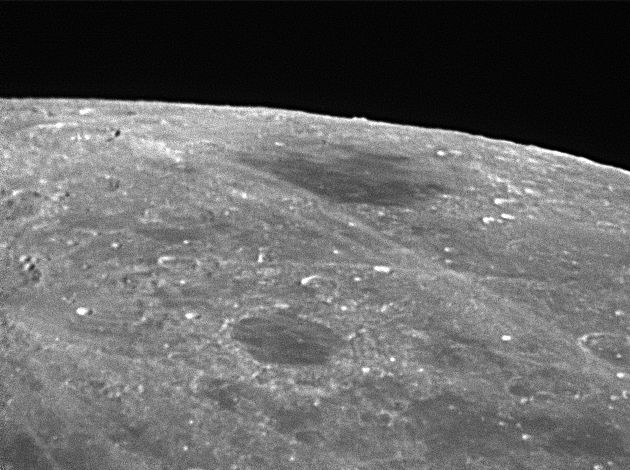Mare Humboldtianum 
Mare Humboldtianum occupies a large impact basin on the north-eastern limb of the Moon and is only well seen during periods of exceptional libration. The mare is about 160 Km wide but lies within a 300-km wide inner ring of the basin. The outer ring is 600 Km in diameter and passes from Strabo, close to Endymium A, and around Mercurius E before extending round to the far side of the Moon.
Mare Humboldtianum is one of only two maria named after a person (Mare Smythii is the other). Alexander von Humboldt was a 17th-century explorer who charted many unknown areas of the Earth. He was a friend of the great lunar cartographer Johann Mädler who named this mare after him because he felt that his exploration of unknown lands on Earth had a symbolic similarity to the way this mare connects the known and unknown parts of the Moon.
Move your mouse over the picture to see the names of the various features.

|
This picture of Mare Humboldtianium was taken when the libration was particularly favourable at 7° 19' in longitude and 2° 59' in latitude. Consequently the mare is particularly clearly displayed. The inner ring of mountains can be seen all the way around. The group of black-lettered craters south of the mare are named from the crater Boss which is beyond the right-hand edge of the picture.
The scale markers are approximately 100 Km north and west and apply at Endymium. Such markers are unreliable in pictures near the limb or near the pole; this picture is both. The diameter of the Humboldtianum inner basin is about 300 Km.
The picture was taken in infrared light using an Atik 1-HS camera attached to my LX200 on 9th June 2008 at 20:20 UT, when the Moon was 6.6 days old.
Lunar Phase: 99.0°
Colongitude: 343.6°
Date and Time: 9th June 2008 20:20 UT
Camera: Atik 1HS with IR-pass filter
Telescope: LX200 at prime focus
Capture: K3CCDTools. Low gamma, 1/250", 30% gain, 919 frames
Processing: Registax. 368 frames stacked. Histogram 0-190, wavelet 1-2 = 10
|
|

|
Another picture of Mare Humboldtianium taken when the libration was very similar at 7° 30' in longitude and 3° 15' in latitude, but the lighting is completely different. This means that in this picture the Sun was at an altitude of about 38° in the southern sky of Endymion. So the shadows are short and the scene looks very flat compared with the picture above where the Sun was about 16° above the eastern horizon. In that picture therefore any cliffs facing the camera are in darkness and the terraine shows up.
.
The picture was taken in H-alpha light using a DMK 21AF04 camera attached to my LX200 on 23rd May 2010 at 20:36 UT, when the Moon was 10.5 days old.
Lunar Phase: 52.1°
Colongitude: 35.0°
Date and Time: 23rd May 2010 20:36 UT
Camera: DMK 21AF04 with H-alpha filter
Telescope: LX200 at prime focus
Capture: ICCapture. Gamma 10, 1/91", gain 877, 2017 frames
Processing: Registax. 51 frames stacked. Histogram 0-184, wavelet 1-2 = 10, gamma 0.8
|
Home Back to NE Quadrant

